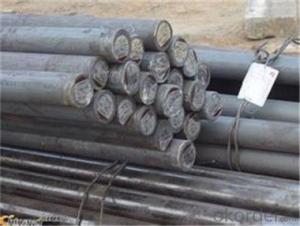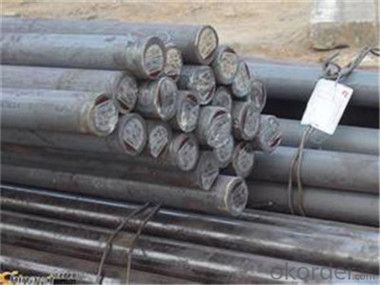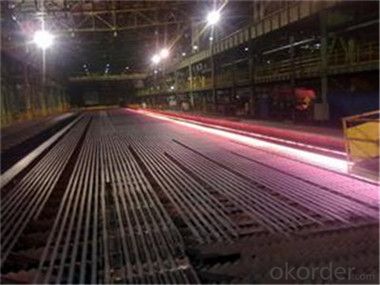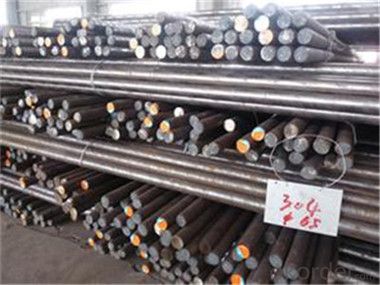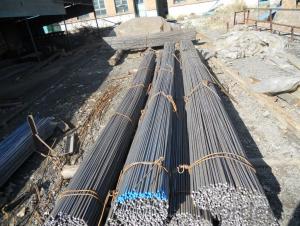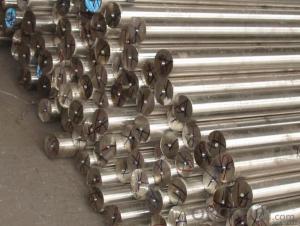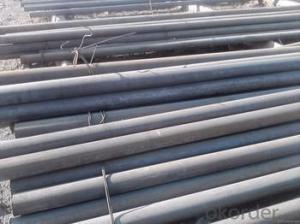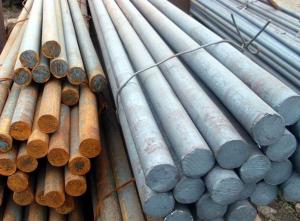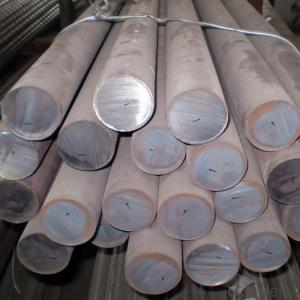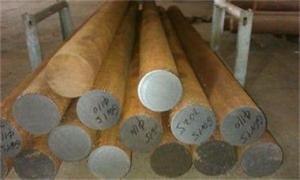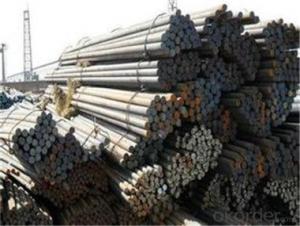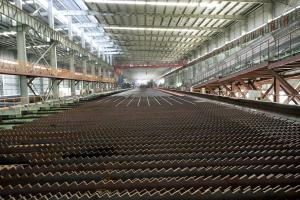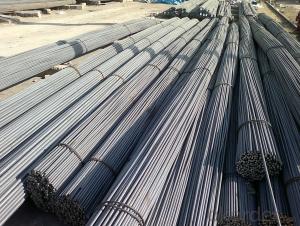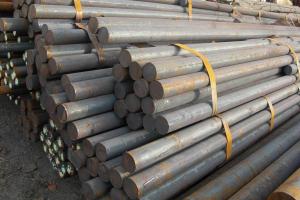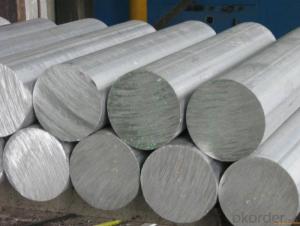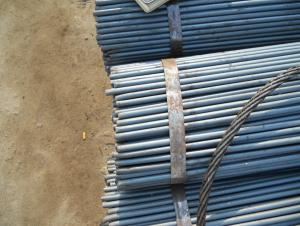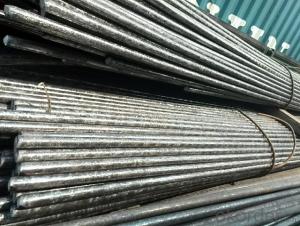Hard Chrome Carbon Steel Round Bar Free Cutting
- Loading Port:
- Tianjin
- Payment Terms:
- TT OR LC
- Min Order Qty:
- 20 m.t.
- Supply Capability:
- 2000000 m.t./month
OKorder Service Pledge
OKorder Financial Service
You Might Also Like
Specification
Description of steel round bar:
1. Commodity: Round steel bar
3. Technical: Hot rolling
2. Length: Min. 5.8meter, according to requirement.
3. Diameter: 16mm-250mm
5. Packing: In Bundle or according to your requirements.
Festures of steel round bar:
1.Dia 80-800mm Length:2000-13000mm or as required
2.Technique:Forged
3.Delivery Time:45 days
Specifications of steel round bar:
1. Commodity: Round steel bar
3. Technical: Hot rolling
2. Length: Min. 5.8meter, according to requirement.
3. Diameter: 16mm-250mm
5. Packing: In Bundle or according to your requirements.
4. Standard: GB/T 3077-1999(42CrMo) ; JIS SCM440; DIN 42CrMo4 ; ASTM 4140 ; BS 708M40 Carbon steel rod applies to chemical industry, shipping industry,manufacturing industry,construction,decorate Industry,electric power,pump shafts, sanitary wares,furniture handles,boiler,high temperature resistant,low temperature resistant, corrosion resistant. If you are interested in these products, just feel free to contact us. Our best quotation will be sent without any delay. we sincerely
hope we can establish a long business relationship.
Images of coffee machine:
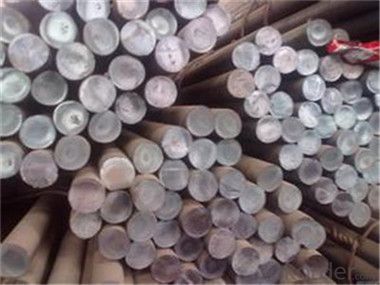
FAQ:
1. What is your main market?
We mainly export to Asia such as Japan,Korea,Thailand and North America and Middle East.
2. How long is the lead time?
Delivery time: 45 days after order confirmed.
3. What payment term do you accept?
Payment: T/T or L/C at sight.
- Q: How are steel round bars used in the manufacturing of valves and fittings?
- Valve and fitting manufacturing commonly utilizes steel round bars for their strength, durability, and versatility. These bars serve as the primary raw material for various valve and fitting components. A significant application of steel round bars in valve manufacturing involves producing valve stems. Valve stems control fluid or gas flow through the valve. The round bars are machined and threaded to create the stem, which connects to the valve disc or plug. Steel round bars are chosen for this purpose due to their high tensile strength, ensuring the stem can withstand the required pressure and torque to operate the valve. In fittings manufacturing, steel round bars are frequently used to produce threaded connectors, nipples, and couplings. These components are integral for joining pipes or tubes, enabling fluid or gas transfer in different systems. Steel round bars are easily machinable, allowing manufacturers to create precise threads and shapes necessary for these fittings. Additionally, steel round bars are also employed in fabricating the body or housing of valves and fittings. The bars can be cut, forged, or machined into the desired shape, providing a robust and dependable structure for the valve or fitting. The use of steel in the body guarantees the component's ability to endure high pressures, temperature fluctuations, and corrosive environments. In conclusion, steel round bars have a crucial role in valve and fitting manufacturing. Their strength, durability, and machinability make them an exceptional choice for creating vital components like valve stems, threaded connectors, and the bodies of valves and fittings.
- Q: How strong are steel round bars compared to other materials?
- Steel round bars, renowned for their exceptional strength and durability, are widely recognized as one of the toughest materials available. In comparison to aluminum, brass, and wood, steel round bars boast a significantly higher tensile strength, referring to their capacity to withstand pulling forces without succumbing to breakage. Moreover, steel round bars are capable of handling higher compressive loads, rendering them highly suitable for applications involving substantial pressure or heavy loads. Not only do steel round bars exhibit remarkable strength, but they also showcase excellent ductility, allowing for easy shaping and bending without any risk of fracture. This remarkable feature grants steel round bars versatility, which explains their extensive utilization in diverse industries such as construction, automotive, manufacturing, and aerospace. While other materials possess their own distinctive properties and applications, steel round bars consistently remain the preferred choice in terms of strength and reliability. Their ability to endure high loads, resist deformation, and maintain structural integrity positions them as a favored option for structural components, shafts, axles, and various other demanding applications.
- Q: What are the different types of steel round bar surface finishes for corrosion resistance?
- There are several different types of steel round bar surface finishes that are commonly used for corrosion resistance. These finishes provide a protective coating on the surface of the bar, preventing contact with corrosive elements and reducing the risk of rusting or degradation over time. One of the most popular finishes for corrosion resistance is hot-dip galvanizing. This involves immersing the steel round bar in a bath of molten zinc, which forms a layer of zinc coating on the surface. The zinc acts as a sacrificial anode, corroding before the steel does, and providing long-lasting protection against rust and corrosion. Another common surface finish for corrosion resistance is stainless steel. This type of steel contains a minimum of 10.5% chromium, which forms a passive oxide layer on the surface when exposed to oxygen. This layer acts as a barrier, preventing further oxidation and corrosion, making stainless steel round bars highly resistant to rust and other forms of corrosion. Electroplating is another method used to provide corrosion resistance to steel round bars. This process involves immersing the bar in an electrolyte solution and passing an electric current through it. This causes a layer of metal, such as zinc or nickel, to be deposited onto the surface of the bar, providing a protective coating. Powder coating is a popular choice for steel round bars that require both corrosion resistance and aesthetic appeal. This process involves applying a dry powder coating to the surface of the bar and then curing it under heat. The powder melts and forms a hard, durable finish that provides excellent corrosion resistance while also offering a wide range of color options. Additionally, there are specialized coatings available for specific applications, such as epoxy coatings or polymer coatings. These coatings are designed to provide superior resistance to certain corrosive environments, such as exposure to chemicals or high humidity. In summary, the different types of steel round bar surface finishes for corrosion resistance include hot-dip galvanizing, stainless steel, electroplating, powder coating, and specialized coatings. Each of these finishes offers varying levels of protection against rust and corrosion, and the choice of finish depends on factors such as the specific application, environmental conditions, and desired aesthetics.
- Q: What are the different types of heat treatments applied to steel round bars?
- Steel round bars can undergo various heat treatments to enhance their mechanical properties and improve their performance in different applications. Some commonly used heat treatments include: 1. Annealing: Steel round bars are heated to a specific temperature and then slowly cooled. This process relieves internal stresses, improves ductility, and increases toughness. 2. Normalizing: Steel round bars are heated above the critical transformation point and then cooled in still air. Normalizing improves the structure and mechanical properties of the steel, making it more uniform and reducing residual stresses. 3. Quenching: Steel round bars are rapidly cooled by immersing them in a quenching medium like oil or water. This heat treatment transforms the austenite phase into martensite, increasing the hardness and strength of the steel. 4. Tempering: After quenching, the hardened steel round bars are reheated to a specific temperature and slowly cooled. Tempering reduces brittleness and improves toughness and ductility while maintaining an appropriate level of hardness. 5. Stress Relieving: This heat treatment is used to reduce residual stresses in the steel round bars that may have been introduced during previous manufacturing processes. The bars are heated to a temperature below the transformation point and slowly cooled. Stress relieving improves dimensional stability and reduces the risk of distortion or cracking. 6. Case Hardening: Carbon or nitrogen is introduced into the outer layer of the steel round bars, creating a hard and wear-resistant surface while maintaining a tough and ductile core. These examples illustrate the different heat treatments that can be applied to steel round bars. The choice of heat treatment depends on the desired mechanical properties and specific application requirements.
- Q: What is the difference between a peeled and a polished steel round bar?
- Two distinct types of steel bars are the peeled steel round bar and the polished steel round bar, each with unique characteristics and applications. The peeled steel round bar is obtained through a peeling process, which involves the removal of the outer surface of the bar. This results in a smooth and clean finish, eliminating any imperfections or scale. The peeled steel round bar is highly suitable for applications requiring a smooth surface, such as the manufacturing of precision components, shafts, or spindles. The peeling process also enhances the mechanical properties of the bar, improving its strength and toughness. In contrast, the polished steel round bar undergoes a polishing process to achieve a shiny and reflective surface. This process utilizes abrasive materials to eliminate surface imperfections, scratches, or dullness. As a result, the polished steel round bar is often employed in decorative applications, architectural designs, or industries that prioritize visually appealing finishes, such as furniture manufacturing or automotive accessories. To summarize, the primary distinction between the peeled and polished steel round bar lies in their respective processes and intended uses. The peeled steel round bar is processed to eliminate imperfections and enhance mechanical properties, making it suitable for precision components. Conversely, the polished steel round bar is processed to create a shiny and reflective surface, making it ideal for decorative or visually appealing applications.
- Q: What are the different testing methods used for steel round bars?
- There are several testing methods used for steel round bars to ensure their quality and suitability for various applications. These methods include: 1. Visual Inspection: This is the initial step of testing, where the bars are visually examined for any visible defects, such as cracks, surface irregularities, or improper dimensions. 2. Dimensional checks: Steel round bars undergo dimensional checks to verify their diameter, length, and straightness. Precise measurements are essential to meet the specified requirements. 3. Ultrasonic Testing: Ultrasonic waves are passed through the round bars to detect internal defects, such as cracks, voids, or inclusions. This method helps identify potential weaknesses that may affect the structural integrity of the bars. 4. Magnetic Particle Inspection: This method uses a magnetic field and magnetic particles to detect surface and near-surface defects like cracks, seams, or laps. It is particularly useful in ferromagnetic materials such as steel. 5. Dye Penetrant Inspection: This technique involves applying a colored dye to the surface of the round bars and then wiping it off. The dye penetrates into any surface cracks or defects, making them visible under ultraviolet light. 6. Hardness Testing: This test measures the hardness of the steel round bars using methods like Rockwell or Brinell scales. It helps determine the material's ability to withstand external forces and ensures it meets the required hardness specifications. 7. Tensile Testing: Tensile strength testing is conducted to measure the maximum load a steel round bar can bear before it breaks. This test helps evaluate the material's strength and ductility. 8. Chemical Analysis: Chemical analysis is performed to determine the composition of the steel round bars, including the presence of elements like carbon, manganese, sulfur, phosphorus, and others. It ensures that the steel meets the required chemical composition standards. These testing methods are crucial in ensuring the quality, reliability, and compliance of steel round bars with industry standards and customer requirements. It is essential to perform a combination of these tests to ensure the overall quality and performance of the steel round bars in different applications.
- Q: Can steel round bars be used in structural applications?
- Yes, steel round bars can be used in structural applications. Steel round bars are commonly used in construction and engineering projects where strength and durability are important. They are versatile and can be used for various structural elements such as beams, columns, and supports. Steel round bars have excellent mechanical properties, including high tensile strength and good ductility, making them suitable for withstanding heavy loads and resisting deformation. Additionally, steel round bars can be easily joined or connected to other structural components, making them a popular choice in the construction industry.
- Q: What are the different standards for steel round bars?
- There are several different standards for steel round bars, which vary by country and industry. Some of the commonly used standards include: 1. ASTM A36: This standard is widely used in the United States and specifies the requirements for carbon structural steel, including round bars. It covers the chemical composition, mechanical properties, and dimensional tolerances of the steel. 2. EN 10025: This European standard covers structural steel, including round bars, and is used in many European countries. It defines the chemical composition, mechanical properties, and technical delivery conditions for the steel. 3. JIS G3101: This Japanese standard is commonly used in Asia and specifies the general requirements for hot-rolled steel, including round bars. It covers the chemical composition, mechanical properties, and dimensional tolerances of the steel. 4. DIN 17100: This German standard is widely used in Germany and other European countries. It defines the general structural steels, including round bars, and provides details on the chemical composition, mechanical properties, and technical delivery conditions. 5. BS 970: This British standard covers various types of steel, including round bars, and provides specifications for their chemical composition, mechanical properties, and dimensional tolerances. These are just a few examples of the many standards for steel round bars. It's important to consult the appropriate standard for specific applications to ensure the desired properties and quality of the steel.
- Q: Can steel round bars be used for making electrical system components?
- Yes, steel round bars can be used for making electrical system components. However, they may not be the most common choice for such applications. Other materials like copper or aluminum are more often used due to their better electrical conductivity. Steel round bars can still be employed for certain electrical components where conductivity is not the primary concern, such as support structures or housings.
- Q: Can steel round bars be used in the construction industry?
- Yes, steel round bars are commonly used in the construction industry for various applications. They are often used as reinforcement in concrete structures, such as beams, columns, and slabs, to enhance their strength and durability. Steel round bars can also be used in the fabrication of structural components, such as trusses, frames, and supports, due to their high tensile strength and resistance to bending or breaking. Additionally, they can be employed in the construction of bridges, tunnels, buildings, and other infrastructure projects.
Send your message to us
Hard Chrome Carbon Steel Round Bar Free Cutting
- Loading Port:
- Tianjin
- Payment Terms:
- TT OR LC
- Min Order Qty:
- 20 m.t.
- Supply Capability:
- 2000000 m.t./month
OKorder Service Pledge
OKorder Financial Service
Similar products
Hot products
Hot Searches
Related keywords
